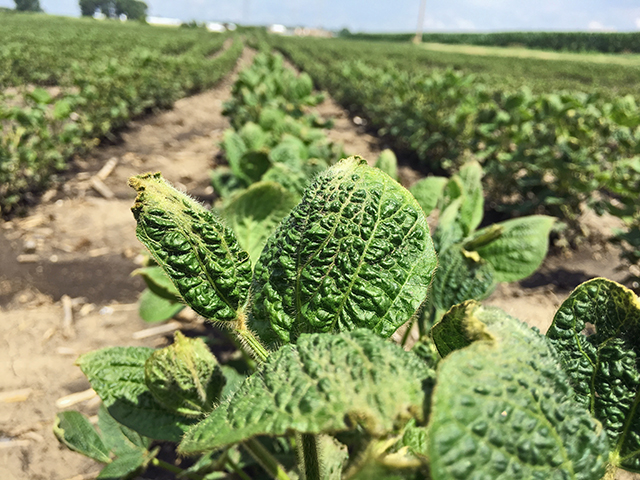Dicamba Label Updates
Regulations - Dicamba Label Updates
For the fourth time in five years, farmers and applicators face a new set of requirements to spray dicamba over the top of dicamba-tolerant crops.
The stakes for getting it right remain high. Parts of the Midwest and South have seen many consecutive years of off-target dicamba injury to a broad array of crops and plants. This year, dicamba-susceptible soybean acres are projected to increase, as well, with Corteva Agriscience estimating that susceptible Enlist E3 soybeans alone could account for more than 30% of all U.S. soybean acreage in 2021. LibertyLink GT27, HPPD-tolerant soybeans and non-GM soybeans are also sensitive to dicamba.
The EPA granted five-year extensions to three dicamba herbicides: XtendiMax (Bayer), Engenia (BASF) and Tavium (Syngenta). EPA also granted a registration to Corteva for its dicamba herbicide, FeXapan, but the company has opted not to market it.
NEW CUTOFF DATES
For the first time, EPA has established two federal cutoff dates for use of the three herbicides: June 30 for soybeans and July 30 for cotton.
For Engenia, those cutoff dates are the only spray timing restriction. The XtendiMax label also tells applicators not to spray the product beyond the R1 growth stage in soybeans, and Tavium's label bans applications after V4 in soybeans and the 6-leaf stage in cotton.
However, dicamba cutoff dates will vary by state in 2021. Three states have opted to create more restrictive dates, either by state rulemaking or via relevant state laws. As of press time, here are the cutoff dates growers face in the following states:
> Arkansas: May 25 (However, a proposed rule to follow the federal cutoffs is underway.)
> Illinois: June 20, with an additional 85°F temperature restriction
> Indiana: June 20
Plan your herbicide-tolerant crop platform accordingly, Purdue University weed scientist Bill Johnson cautions. "There is no wiggle room for double-crop soybean growers," he says of Indiana's cutoff. "Double-crop soybean growers should use a technology that allows you to spray after June 20."
Other states, such as North Carolina, Oklahoma and Texas, have attempted to develop Section 24(c) special local needs labels to extend the federal cutoff dates to accommodate late-planted soybean and cotton fields. However, EPA has stated that it does not intend to grant these extensions based on concerns of legal liability to the agency and the higher risk of off-target movement from late-season applications.
BUFFERS GET BIGGER
The new labels also include expanded buffers, designed to limit off-target movement. The first required buffer is a 240-foot downwind buffer, and it is necessary for every dicamba application.
P[L1] D[0x0] M[300x250] OOP[F] ADUNIT[] T[]
The second buffer requirement is a 57-foot omnidirectional buffer, combined with a 310-foot downwind buffer in counties deemed to have federally recognized endangered species.
Do not assume that if a county didn't surface on the EPA website last year that it won't be on it this year. The EPA has updated its listing of counties with endangered species in several states, adding some counties and removing others. Dicamba applicators are required to document that they checked this website before spraying.
Soybean growers have the option of reducing the downwind buffer to 110 feet and the endangered species buffer to 240 feet if they used a qualified hooded sprayer option.
However, cotton acres do not qualify for this buffer reduction, and ultimately, many growers may have to leave substantial portions of their field unsprayed because of these new buffer requirements, Johnson says. Have a plan for weed control on those field edges, he advises.
TANK-MIX REQUIREMENTS
None of the three newly labeled dicamba herbicides can be used alone; all must be accompanied in the tank with a volatility-reducing agent (VRA) designed to keep the tank mix's pH at or above 5, which research shows lowers the risk of volatility.
If an applicator wants to tank-mix other active ingredients, such as herbicides with XtendiMax, Engenia or Tavium, they must first check the list of approved tank-mix options to see whether that it is an approved tank mix partner and whether it requires the additional use of a drift-reduction agent (DRA).
MANY OLD RULES STILL APPLY
Many parts of the new dicamba labels remain the same. Only certified applicators can apply the three dicamba herbicides, which remain restricted-use pesticides.
Dicamba or auxin-specific training is required annually for all dicamba applicators using these newly labeled herbicides.
Applicators must keep applications within 3 to 10 mph wind speeds at sprayer speeds at or below 15 mph, and with boom height no more than 24 inches above the crop canopy. If the wind is blowing toward a sensitive crop or area, stop spraying, regardless of wind speed.
Dicamba applications are still prohibited within 48 hours of a heavy-rain forecast, as well as during temperature inversions. Spray windows are limited to one hour after sunrise and two hours before sunset.
In addition to checking the EPA Bulletins Live! Two website, applicators are still required to check a sensitive crop registry, such as FieldWatch, for each field before applications.
AMS (ammonium sulfate) and nonapproved nozzles are still banned from use with these herbicides. Triple-rinse cleanout procedures are still required.
Applicators are also still required to generate records of all the label requirements within 72 hours of an application, and keep those records for two years.
**
FOR MORE INFORMATION:
DTN's handy chart that breaks down the changes in the new dicamba labels: https://www.dtnpf.com/…
Applicators can find the approved VRAs, tank-mix options and their DRA requirements on each herbicide's website:
> XtendiMax: www.xtendimaxapplicationrequirements.com/#
> Engenia: www.engeniaherbicide.com/tank-mix.html
> Tavium: www.syngenta-us.com/herbicides/tavium-tank-mixes
Find FieldWatch, a nationwide sensitive crop registry,
at fieldwatch.com
Check endangered species status at www.epa.gov/endangered-species/bulletins-live-two-view-bulletins
[PF_0421]
(c) Copyright 2021 DTN, LLC. All rights reserved.




